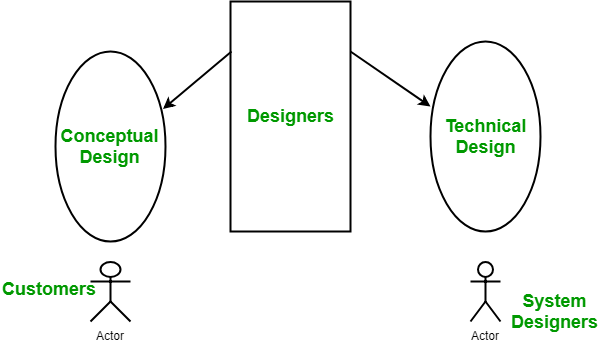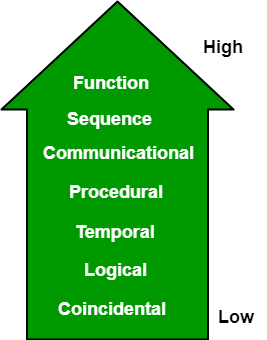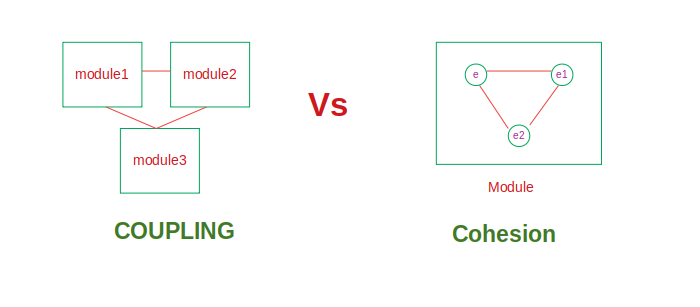Usually the greater the cohesion of each module in the system the lower the coupling between modules is. With examples Or b Explain in detail types of cohesion and coupling with.

Software Engineering Coupling And Cohesion Geeksforgeeks
Increasing in coupling is avoided for software.

. The purpose of functional cohesion is single minded strong and focused. Based on these possible dependencies the coupling in software engineering is classified into six different types of coupling. It is an ideal situation.
Cohesion and coupling are clearly related. Comments 0 0 0. Is it true that whenever we increase.
A module having high cohesion and low coupling is said to be functionally independent of other modules. Course Title CS 121. Because it is unplanned it may serve confusion to the programmers and is generally not-accepted.
The scale for cohesion is nonlinear. Explain the different types of cohesion that a module might exhibit. Coupling methods can be classified into two major types the strong coupling method ie the direct coupling method and the weak coupling method ie the iterative coupling method.
Clamp or split-muff or compression coupling and Flange coupling. What is coupling and cohesion in reference to software design. The content coupling exists when the modules share the code.
Cohesion shows the relationship within the module. Coupling is an indication of the relative interdependence among modules. Key Differences Between Cohesion and Coupling Cohesion is creating interconnections within the module while coupling involves building connectivity between the modules.
Every essential element for a single computation is contained in the component. There are seven types of cohesion namely Co-incidental cohesion - It is unplanned and random cohesion which might be the result of breaking the program into smaller modules for the sake of modularization. Explain in detail different types of Cohesion and coupling.
There are several levels of Cohesion. Coupling is about how much one module depends or interacts with other modules. Functional Cohesion The execution of the task related to the problem is the only concern from all the elements inside the module.
An element outputs some data that becomes the input for other element ie data flow between the parts. By the term functional independence we mean that a cohesive module performs a single task or function. Cohesion is a measure of the functional strength of a module.
Coupling represents the relationships between modules. Cohesion shows the modules relative functional strength. With examples or b explain in detail types of.
How are these concepts useful in arriving at a good design of a system. Cohesion is about how well elements within a module belong together and serve a common purpose. Cohesion represents the functional strength of modules.
Software Architecture Design course explain coupling and the types of cohesion in detail also explain java code problem which we face caused By the following cohesion types. Flexible coupling Bushed pin-type coupling Universal coupling and Oldham coupling. Coupling is also called Inter-Module Binding.
Coincidental Logical Temporal Procedural Communicational Sequential Functional Coincidental is the lowest level and functional is the highest. Cohesion represents the relationship within module. Types of Coupling Following are the different types of coupling.
Please explain it with more examples Cohesion and Coupling. Types of Cohesion. The strong coupling method solves coupled equations directly and updates all variables of the coupled system simultaneously.
Cohesion and Coupling deal with the quality of an OO design. Cohesion-Cohesion is a natural extension of the information hiding concept. This resource can be a functional behavior a common interface a common field in a user interface the data picked from a field and shared between two modules a transaction shared between two modules etc.
Below are several types of cohesion in software engineering. One of the most important goals of object oriented design is to have high cohesion classes and loose coupling between these classes. All the elements in the module perform only the necessary activities.
Explain in detail different types of Cohesion and coupling. A functional cohesion performs the task and functions. Increasing in cohesion is good for software.
Coupling is the concept of inter module. Coupling shows the relative independence between the modules. It occurs naturally in.
There are seven types of cohesion namely Co-incidental cohesion - It is unplanned and random cohesion which might be the result of breaking the program into smaller modules for the sake of modularization. Thus cohesion is an intra-module concern whereas coupling cuts across modules. Coupling shows the relationships between modules.
A cohesive module performs a single task within a. Pages 88 This preview shows page 87 - 88 out of 88 pages. School Amrita Vishwa Vidyapeetham.
Software Architecture Design course explain coupling and the types of cohesion in detail also explain java code problem which we face caused By the following cohesion types Question. Cohesion is also called Intra-Module Binding. Cohesion In computer programming cohesion refers to the degree to which the elements of a module belong together.
Types of Cohesion Types of Coupling Logical Temporal Procedural Sequential Cohesion Content Common Control Data Message No Coupling Munaam Munawar Follow Coupling Cohesion and there Types 1. Two OO Design Principles Null Loose coupling and high cohesion. Cohesion may be represented as a spectrum We always strive for high cohesion although the mid-range of the spectrum is often acceptable.
Because it is unplanned it may serve confusion to the programmers and is generally not-accepted. Types of cohesion- 1. Rigid Coupling Sleeve or muff coupling.
Gear coupling Bellow coupling Jaw couplings Diaphragm couplings Fluid Coupling.

Difference Between Cohesion And Coupling Programmerbay

0 Comments